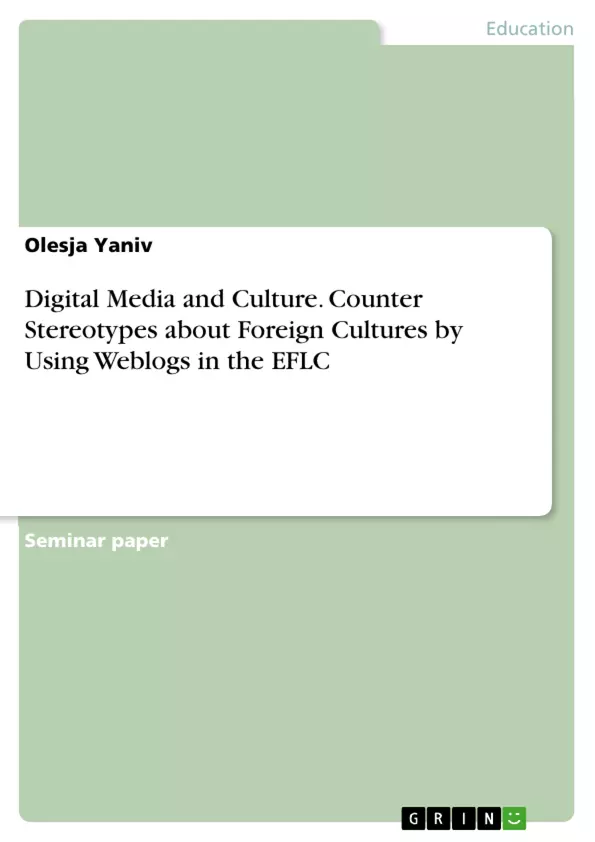New media – especially the personal computer – play a significant part in people´s private area as well as in the occupational area. Thus, there is talk about transition of industrial society into an information society. Such transition has been fulfilled since the end of the 1960s and includes a digitalized and interconnected world for the greatest extend. Those changes affect the whole everyday reality; an increasingly number of the population spend their time in front of monitors inside a virtual reality. The internet and mobile devices facilitate communication with both, familiar and unknown people all over the world. For the young generation – the so called “digital natives” – the constantly networking and opportunity of gaining knowledge easily became obviously.
Furthermore, the kind of learning has changed as well. Due to the digitalized world knowledge is not only represented differently but also accessible at any place and is not bound to a personal producer or mediator. The digital learners should not “consume” rehashed knowledge anymore but, need to be able to have the ability to use available knowledge and information, screen those usefully and thus, reach efficient learning outcomes. Hence, media literacy becomes a key qualification to participate in the information society.
In the course of lifelong learning and concomitant increasingly compulsion to flexibility of learning, weblogs as a form of e-learning can represent an efficient media to realize a new culture of teaching and learning since contents are spread independently from place and time and are made available for the recipients. Besides, the access to blogs created by people and companies all over the world enables an absorption and participation in foreign cultures, values and perceptions by the digital learners. Blogs make our society more interconnected and self-aware.
By considering the aspects of education and intercultural learning written in the scholastic standards, it is necessary to examine blogs concerning their features and potentials, possible applications in the English foreign language classroom and finally, to provide theory into a practical and realistic teaching unit of a 11th grade at a German advanced level of a high school.
Inhaltsverzeichnis (Table of Contents)
- 1. Introduction
- 2. New Media in the English Foreign Language Classroom
- 3 Defining "Weblogs", Their Features and Applications
- 3.1 Features and Functions of Weblogs
- 3.2 Possible Applications of Weblogs
- 4. Why Teaching with Weblogs? - Potentials and Skills
- 4.1 Communicative Skills
- 4.2 Cultural Awareness through Weblogs as a Key Competency
- 5. Teaching Own and Foreign Stereotypes by Weblogs
- 5.1 Introduce the Blog
- 5.2 Teaching Unit
- 5.2.1 First Teaching Lesson
- 5.2.2 Second Teaching Lesson
- 5.3 Competencies and Learning Targets
- 5.3.1 Intercultural Communicative Competence
- 5.3.2 Text- and Media Literacy
- 5.3.3 Language Awareness
- 6. Conclusion
Zielsetzung und Themenschwerpunkte (Objectives and Key Themes)
This work examines the potential of using weblogs in the English as a foreign language classroom to counter stereotypes about foreign cultures. The author explores the features and functions of weblogs, their applications in education, and the skills they foster in learners. The work culminates in a practical teaching unit designed for an advanced level 11th grade class in a German high school.
- The role of new media, particularly weblogs, in the EFL classroom
- The features and applications of weblogs in promoting communicative skills and cultural awareness
- Developing a teaching unit that utilizes weblogs to challenge stereotypes about foreign cultures
- The importance of intercultural communicative competence, text and media literacy, and language awareness in the EFL classroom
- The relevance of lifelong learning and the integration of digital technologies in education
Zusammenfassung der Kapitel (Chapter Summaries)
The introduction outlines the significance of new media in contemporary society, particularly the transition to an information society characterized by digitalization and interconnectedness. The author emphasizes the shift in learning paradigms, emphasizing the importance of media literacy in navigating a world of easily accessible information. Chapter 2 delves into the use of new media in the EFL classroom, highlighting the abundance of tools available to learners in the digital age compared to the pre-Internet era. The chapter emphasizes the role of multimedia in computer-assisted language learning (CALL), discussing its use for both social communication and information retrieval in the target language. Chapter 3 defines "weblogs," explores their features and functions, and outlines their potential applications in education. Chapter 4 focuses on the advantages of using weblogs for teaching, highlighting their ability to foster communicative skills and promote cultural awareness. Chapter 5 presents a teaching unit that uses weblogs to challenge stereotypes about foreign cultures. This unit comprises two lessons, focusing on the introduction of the blog, the exploration of stereotypes, and the development of key competencies such as intercultural communicative competence, text and media literacy, and language awareness.
Schlüsselwörter (Keywords)
This work explores the use of digital media, particularly weblogs, in the English Foreign Language Classroom (EFLC). The author emphasizes the role of new media in fostering communicative skills, promoting cultural awareness, and challenging stereotypes about foreign cultures. Key concepts include intercultural communicative competence, text and media literacy, and language awareness. The study examines the integration of weblogs as an effective e-learning tool to support lifelong learning and the development of critical thinking skills.
- Arbeit zitieren
- Olesja Yaniv (Autor:in), 2016, Digital Media and Culture. Counter Stereotypes about Foreign Cultures by Using Weblogs in the EFLC, München, GRIN Verlag, https://www.hausarbeiten.de/document/338603


